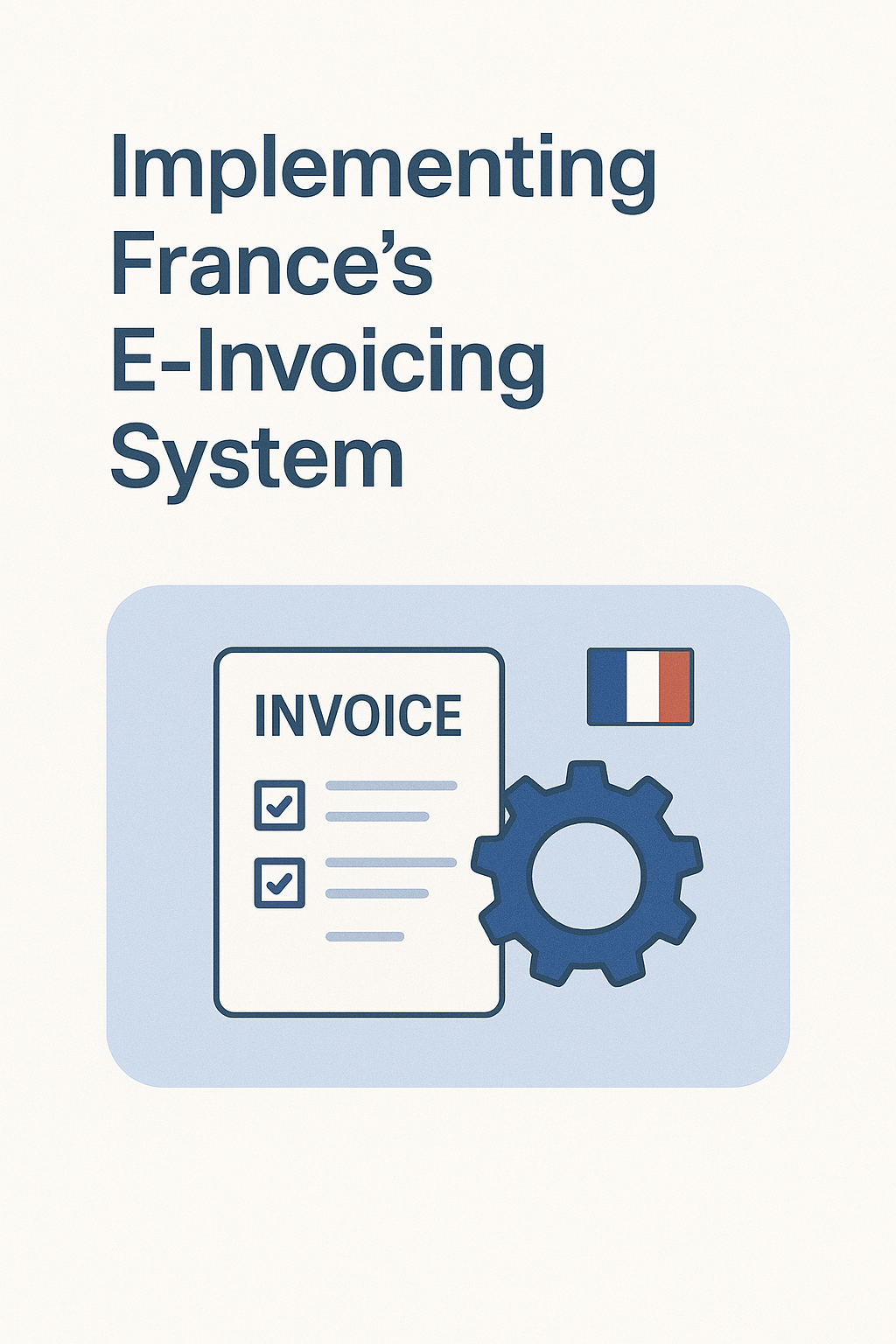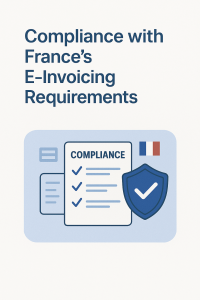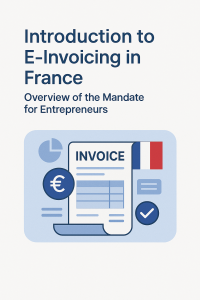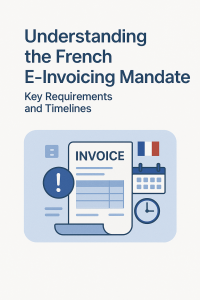Introduction: From Planning to Execution
Over the past three articles, we explored:
- Article 1: The basics of France’s e-invoicing reform and why it matters.
- Article 2: The scope of obligations, from domestic B2B to cross-border e-reporting.
- Article 3: A 90-day readiness plan for preparing your systems and teams.
Now comes the final step: implementation.
For foreign entrepreneurs, implementation is where strategy meets reality. It means selecting a Partner Dematerialisation Platform (PDP) or using the Public Invoicing Portal (PPF), integrating your ERP, testing with real transactions, and putting long-term compliance processes in place.
This article provides a step-by-step roadmap to ensure your business is ready for France’s e-invoicing mandate.
Step 1: Build the Right Project Team
E-invoicing is not just an IT project—it is a cross-functional change.
Your project team should include:
- Finance/Accounting → to define invoice flows, VAT rules, and reporting.
- IT/ERP Specialists → to manage integration with PDP or PPF.
- Tax/Compliance Advisor → to interpret DGFiP rules and ensure legal conformity.
- Operations → to adjust order-to-cash and procure-to-pay workflows.
👉 Tip: If you are a foreign entrepreneur, involve your French accountant or fiscal representative early. They know the local requirements and can liaise with DGFiP if needed.
Step 2: Select a PDP (or Public Portal)
Option 1: Partner Dematerialisation Platform (PDP)
- Registered by DGFiP to ensure compliance.
- Can exchange invoices with other PDPs and the State.
- Provides advanced features: ERP connectors, e-archiving, dashboards, Peppol integration.
- Recommended for businesses with significant invoice volumes or cross-border flows.
Option 2: Public Invoicing Portal (PPF)
- Free service offered by DGFiP.
- Provides basic functionality (sending, receiving, reporting).
- Limited automation and customization.
- Suitable for small businesses or those issuing only a few invoices per month.
👉 Action: Check DGFiP’s list of registered PDPs and compare based on:
- Integration with your ERP/accounting software
- Language support (important for foreign entrepreneurs)
- Archiving options
- Pricing and scalability
Step 3: Integrate Your ERP or Accounting Software
Once you choose your connection route, you must integrate it with your system.
Key integration tasks:
- Configure ERP to generate invoices in UBL, CII, or Factur-X.
- Include new mandatory fields (SIREN, delivery address, operation type, VAT on debits).
- Set up invoice lifecycle management (sent, received, accepted, rejected, paid).
- Connect e-reporting modules for B2C and cross-border.
👉 Example: If you use SAP or Oracle, your vendor may already provide PDP-certified modules. If you use QuickBooks or Xero, you may need a middleware solution.
Step 4: Test with Real Transactions
Testing is critical. You must ensure that:
- Outbound invoices are correctly generated, validated, and transmitted.
- Inbound invoices can be received and processed automatically.
- Lifecycle statuses flow back into your ERP (e.g., client acceptance or rejection).
- E-reporting data matches your VAT obligations.
👉 Tip: Start by testing with a friendly client and supplier before going live across all partners.
Step 5: Implement Archiving and Audit Trail
France requires 10-year invoice archiving with guarantees of:
- Integrity (no unauthorized changes)
- Readability (must remain accessible to humans and systems)
- Traceability (audit log of all changes, lifecycle updates, and metadata)
👉 Options:
- Use your PDP’s certified archiving service.
- Use a separate trusted third-party archive provider.
Remember: Even if a provider stores your invoices, you remain legally responsible.
Step 6: Train and Communicate
Train your teams to:
- Handle e-invoice rejections and corrections.
- Interpret lifecycle statuses.
- Reconcile e-reporting data with VAT returns.
- Use PDP or PPF dashboards.
Communicate with your partners:
- Inform French suppliers and customers that you are e-invoicing ready.
- Share your directory information (SIREN + PDP/PPF choice) so they can route invoices correctly.
Step 7: Monitor Compliance Continuously
DGFiP updates specifications regularly. Being compliant in 2026 does not guarantee compliance in 2027 or beyond.
👉 Best practices:
- Subscribe to DGFiP’s update bulletins (available in French, sometimes in English).
- Ask your PDP to confirm how they handle regulatory updates.
- Review your compliance annually with your French tax advisor.
Common Implementation Challenges
- ERP limitations → Some systems cannot natively produce Factur-X. Solution: middleware or PDP add-ons.
- Master data errors → Wrong SIREN numbers cause invoice rejections. Solution: audit your customer and supplier databases.
- Underestimating e-reporting → Many companies focus only on e-invoicing. Solution: align POS/e-commerce data early.
- Change management resistance → Staff may see e-invoicing as a burden. Solution: highlight automation benefits (less manual entry, fewer disputes).
Implementation Timeline: From Project to Go-Live
A realistic timeline for a foreign entrepreneur with a French subsidiary:
- Months 1–2: Select PDP, define scope, audit master data.
- Months 3–6: ERP integration and customization.
- Months 7–8: Internal testing with sample invoices.
- Months 9–10: Pilot with selected clients and suppliers.
- Months 11–12: Go-live for all invoices and e-reporting.
- Ongoing: Monitoring, updates, and training.
👉 For SMEs with low volumes, this can be shortened—but don’t leave it until 2026.
Future Outlook: Beyond France
France is a front-runner, but not alone. Other EU countries (Italy, Poland, Germany) are also introducing mandatory e-invoicing.
- EU’s “VAT in the Digital Age (ViDA)” initiative may harmonize requirements across the EU by 2030.
- France’s adoption of Peppol as an interoperability standard makes it easier to exchange invoices across borders.
- Businesses that adapt early in France will be better positioned for future EU-wide compliance.
Conclusion: Your Roadmap to Compliance
Implementing e-invoicing in France is a multi-step journey:
- Build your project team.
- Select a PDP or use the PPF.
- Integrate ERP and accounting systems.
- Test with real transactions.
- Implement archiving and audit trail.
- Train your team and communicate with partners.
- Monitor compliance continuously.
For foreign entrepreneurs, the stakes are high—but so are the opportunities. By embracing structured invoicing early, you can reduce administrative costs, improve cash flow visibility, and strengthen your reputation with French clients and suppliers.
👉 This concludes our 4-article series on France’s e-invoicing reform. If you need personalized support, now is the time to engage a French accountant or PDP provider to guide you through the last mile.




